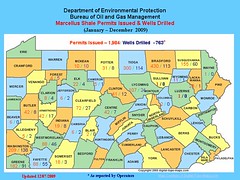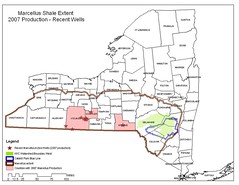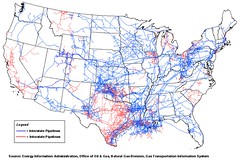Senior Policy Analyst, NRDC
Switchboard: Health and the Environment
Boulder, Colorado
April 6, 2010
NRDC supports federal regulation of hydraulic fracturing under the Safe Drinking Water Act. We believe this is a sensible approach that would ensure a minimum federal floor of drinking water protection in the more than 30 states where oil and gas production occurs.
Opponents of such regulation claim that hydraulic fracturing has never caused any drinking water contamination. They say this because incidents of drinking water contamination where hydraulic fracturing is considered as a suspected cause have not been sufficiently investigated, either because scientists and regulators could not properly investigate (did not have the information or technology needed) or because they chose not to, even where signs clearly point to hydraulic fracturing. Some cases where groundwater was contaminated during hydraulic fracturing operations have been attributed to other causes, such as faulty well structure, even if a well failed during the hydraulic fracturing process.
Below is a list of incidents where drinking water has been contaminated and hydraulic fracturing is a suspected cause. I can't emphasize enough that there are many more cases of drinking water contamination around the country related to oil and gas production; those listed below are cases where a homeowner had enough detailed knowledge to know that a nearby well was recently fractured and specifically included that information in reports. In many cases of drinking water contamination where hydraulic fracturing has not been mentioned as the cause, it may be because the homeowner does not know if the nearby gas well was recently fractured. It does not mean that hydraulic fracturing is completely absolved. As you will see, these cases are not limited to just one company or one state. The stories from around the country are unfortunately familiar.
Please send me other incidents of which you are aware, and I will add them to this list.
Arkansas: In 2008, Charlene Parish of Bee Branch reported contamination of drinking water during hydraulic fracturing of a nearby natural gas well owned by Southwestern Energy Company. Her water smelled bad, turned yellow, and filled with silt.
Arkansas: In 2007, the Graetz family in Pangburn reported contamination of drinking water during hydraulic fracturing of a nearby natural gas well owned by Southwestern Energy Company. The water turned muddy and contained particles that were “very light and kind of slick” and resembled pieces of leather.
Colorado: In 2001, two families in Silt reported a water well blow-out and contamination of their drinking water during hydraulic fracturing of four nearby natural gas wells owned by Ballard Petroleum, now Encana Corporation. Their drinking water turned gray, had strong smells, bubbled, and lost pressure. One family reported health symptoms they believe are linked to the groundwater contamination.
Colorado: In 2007, the Bounds family in Huerfano County reported a pump house exploded and contamination of drinking water during hydraulic fracturing of nearby wells owned by Petroglyph Energy.
New Mexico: A 2004 investigation by the U.S. Environmental Protection Agency found two residents who reported that the quality of their water was affected by hydraulic fracturing.
New York: In 2007, the Lytle family in Seneca County reported contamination of drinking water the morning after hydraulic fracturing of a nearby natural gas well owned by Chesapeake Energy Corporation. The water turned gray and was full of sediment.
New York: In 2009, the Eddy family in Allegany County reported contamination of drinking water during hydraulic fracturing of a nearby well owned by U.S. Energy Development Corporation. The water turned "foamy, chocolate-brown."
Ohio: In 2007, there was an explosion of a water well and contamination of at least 22 other drinking water wells in Bainbridge Township after hydraulic fracturing of a nearby natural gas well owned by Ohio Valley Energy Systems. More than two years later, over forty families are still without clean drinking water and are waiting to be connected to a town water system.
Pennsylvania: In 2009, the Zimmerman family of Washington County reported contamination of drinking water after hydraulic fracturing of nearby natural gas wells owned by Atlas Energy. Water testing on their farm found arsenic at 2,600 times acceptable levels, benzene at 44 times above limits, naphthalene at five times the federal standard, and mercury and selenium levels above official limits.
Pennsylvania: In 2008, two families in Gibbs Hill reported contamination of drinking water after hydraulic fracturing of a nearby natural gas well owned by Seneca Resources Corporation. Their water had strong fumes, caused burning in lungs and sinuses after showering, and caused burning in the mouth immediately upon drinking.
Pennsylvania: In 2009, families in Bradford Township reported contamination of drinking water after hydraulic fracturing of nearby natural gas wells owned by Schreiner Oil & Gas. The drinking water of at least seven families has been contaminated.
Pennyslvania: In 2009, the Smitsky family in Hickory reported contamination of their drinking water after hydraulic fracturing of nearby natural gas wells owned by Range Resources. Their water became cloudy and foul-smelling. Testing found acrylonitrile, a chemical that may be used in hydraulic fracturing. The EPA is now investigating this incident.
Texas: In 2007, three families who share an aquifer in Grandview reported contamination of drinking water after hydraulic fracturing of a nearby well owned by Williams. They experienced strong odors in their water, changes in water pressure, skin irritation, and dead livestock. Water testing found toluene and other contaminants.
Virginia: Citizens reported drinking water contamination after hydraulic fracturing. Water was murky and had oily films, black sediments, methane, and diesel odors. Individuals experienced rashes from showering. The Buchanan Citizens Action Group reported over 100 documented complaints of adverse effects of hydraulic fracturing and the Dickenson County Citizens Committee reported ground water quality deteriorated throughout the county as a result of the large number of hydraulic fracturing events.
Wyoming: Families in the small town of Pavillion have been reporting contamination of their drinking water for at least ten years. Hydraulic fracturing has been used in the many wells in the area owned by Encana Corporation. Drinking water has turned black, smelled bad, and tasted bad. Individuals report medical symptoms they believe are related to water contamination. The U.S. Environmental Protection Agency is investigating and has found contamination in 11 water wells, including toxic chemicals that may be from hydraulic fracturing fluids. Further tests are needed to determine the source of contamination.
Link to Amy Mall's Blog and leave comments: HERE.
Thank you Amy!DEMAND ACCOUNTABILITY!



















Thank you for digging up all this information. I live in Lafayette, Louisiana, where our local economy heavily depends upon the oil and gas industry. Therefore, I wasn't surprised to read an article condemning EPA regulation of hydraulic fracturing. Article found here:
ReplyDeletehttp://www.theind.com/oil-a-gas/5978-leave-this-one-to-the-states
The author basically tries to scare the reader into agreeing with him (in his opposition to regulation) with the usual "it'll destroy our economy!" rhetoric. And I'm pretty sure he knows more about the contamination issue than he proclaims, else he wouldn't have said "If hydraulic fracturing were regualted, the president and liberals in Congress could easily shut down the development of natural gas around the country."
Sorry to fill up your comment section with quotes... My intention was to thank you for providing links to some solid data with which to dispute those that claim this process hasn't caused one single incident of contamination.
Keep up the good work!
Melissa in Lafayette, LA
melissa, thanks for your comments... and thanks for your compliments too!
ReplyDelete